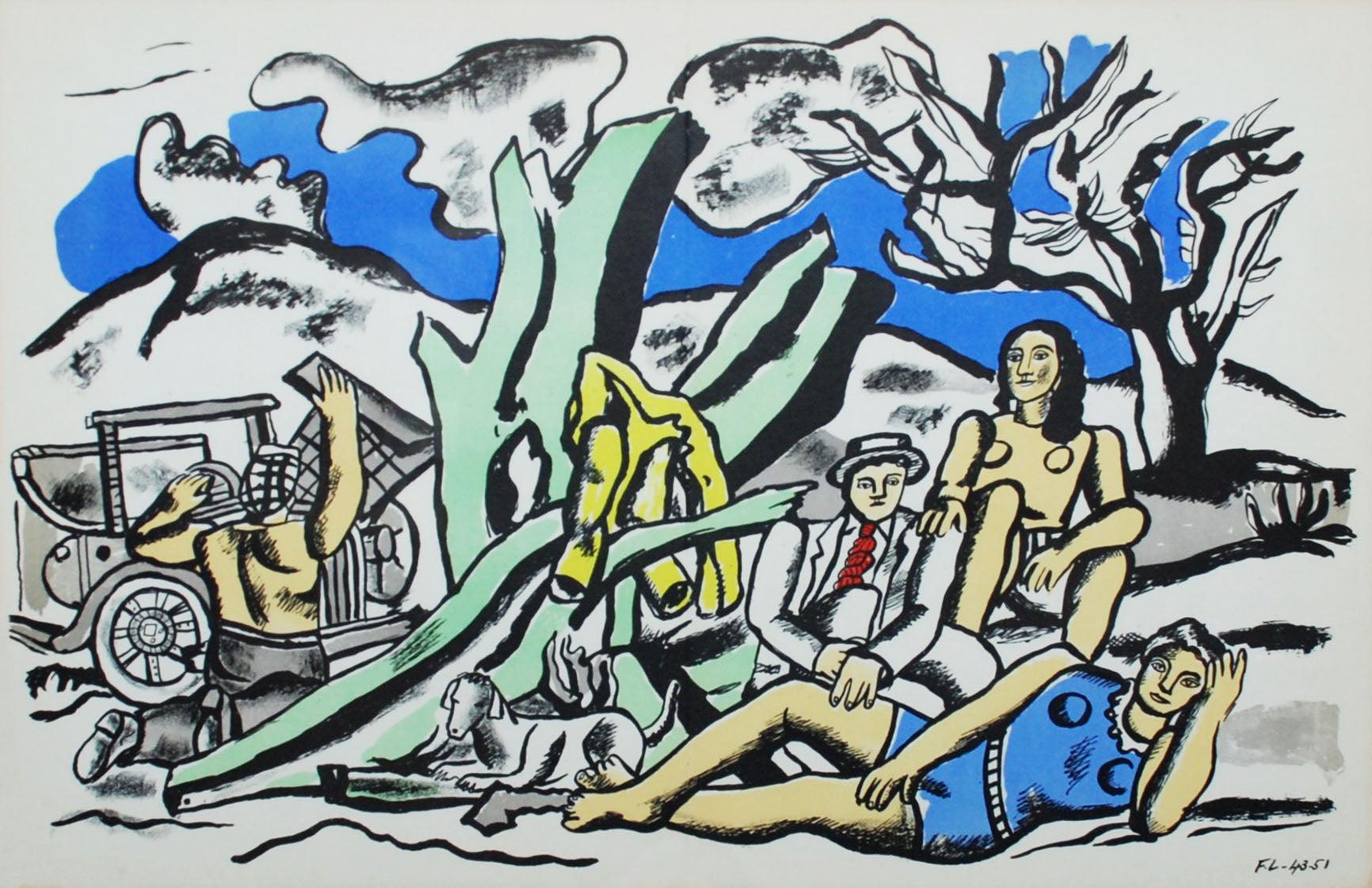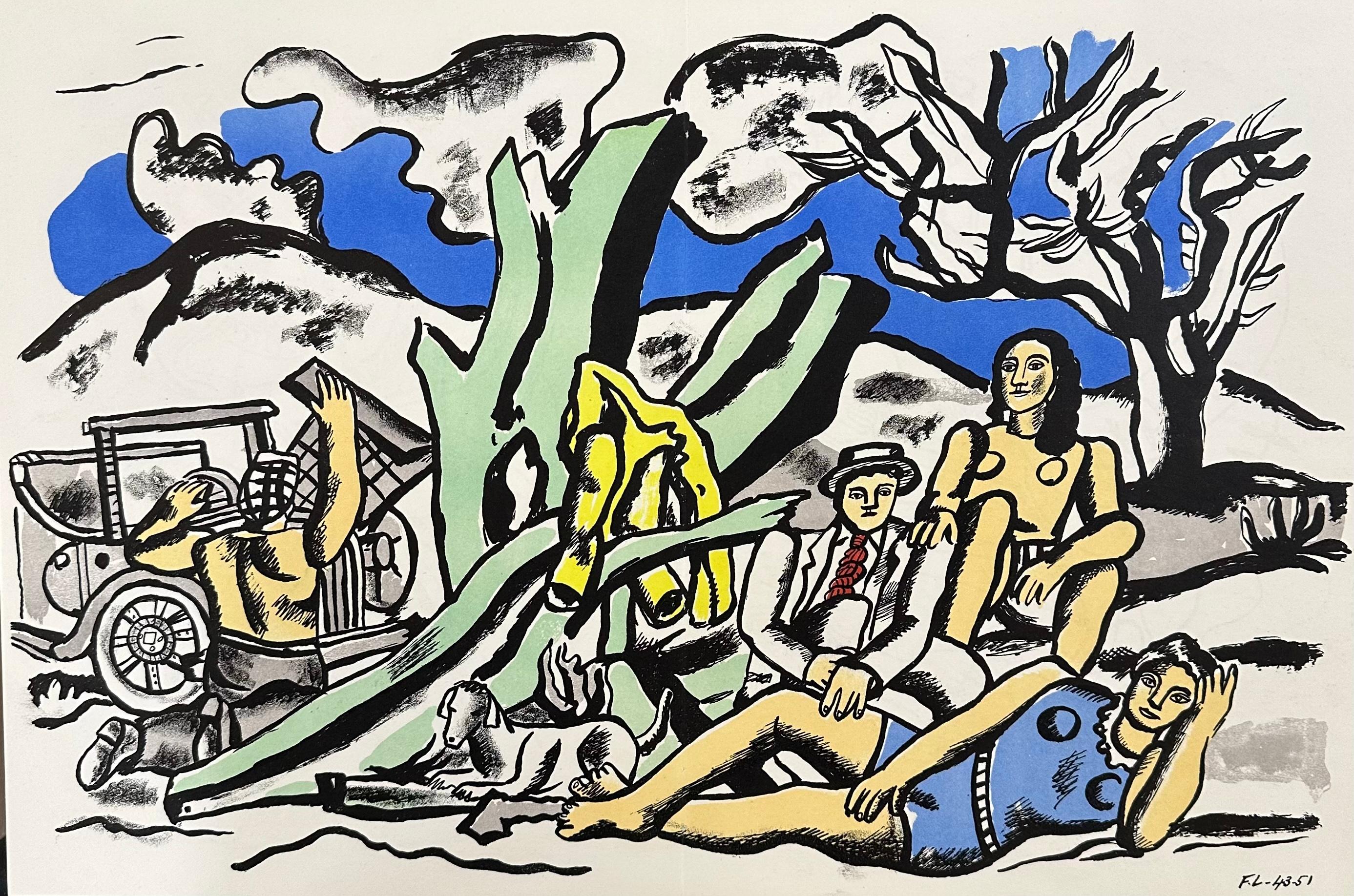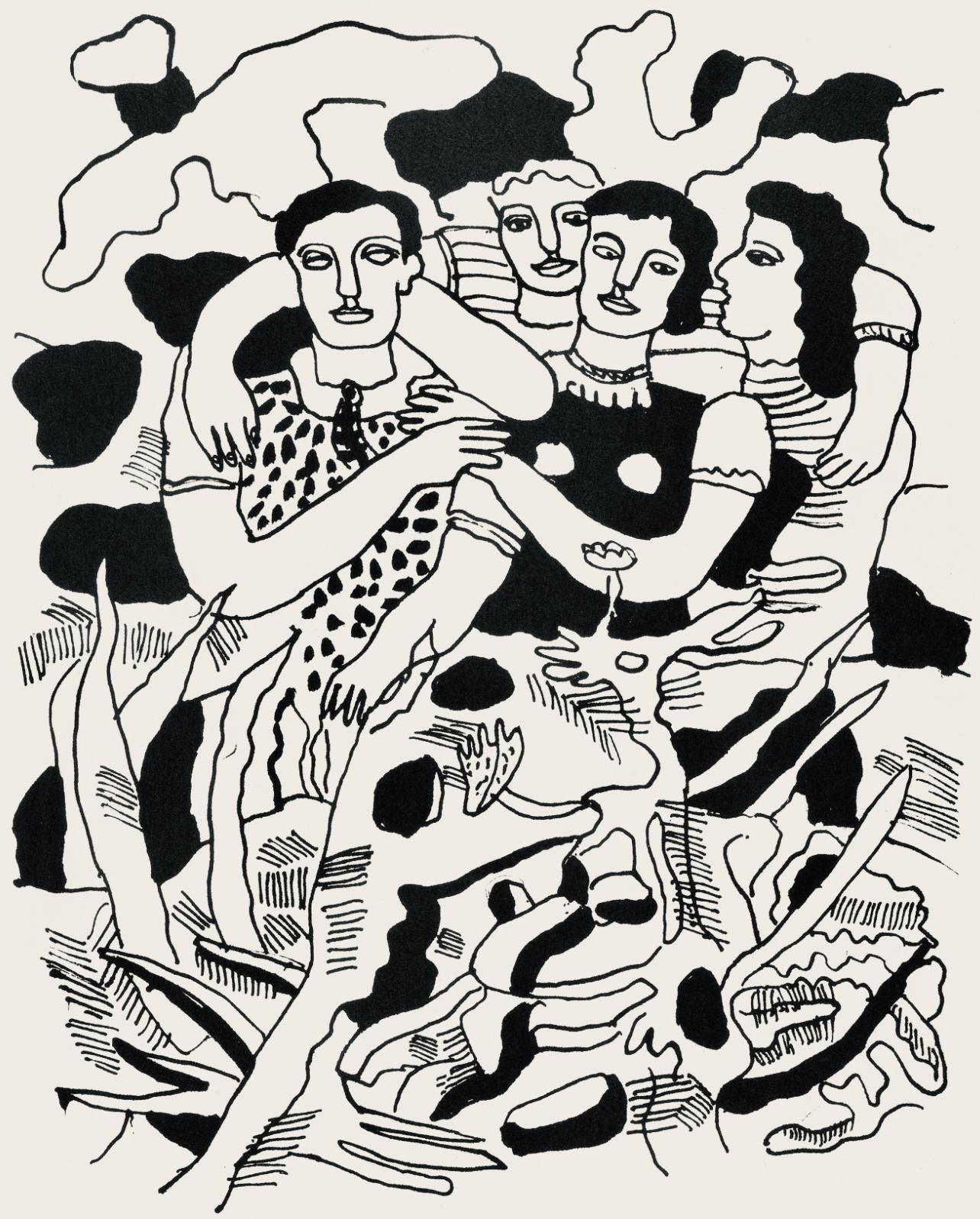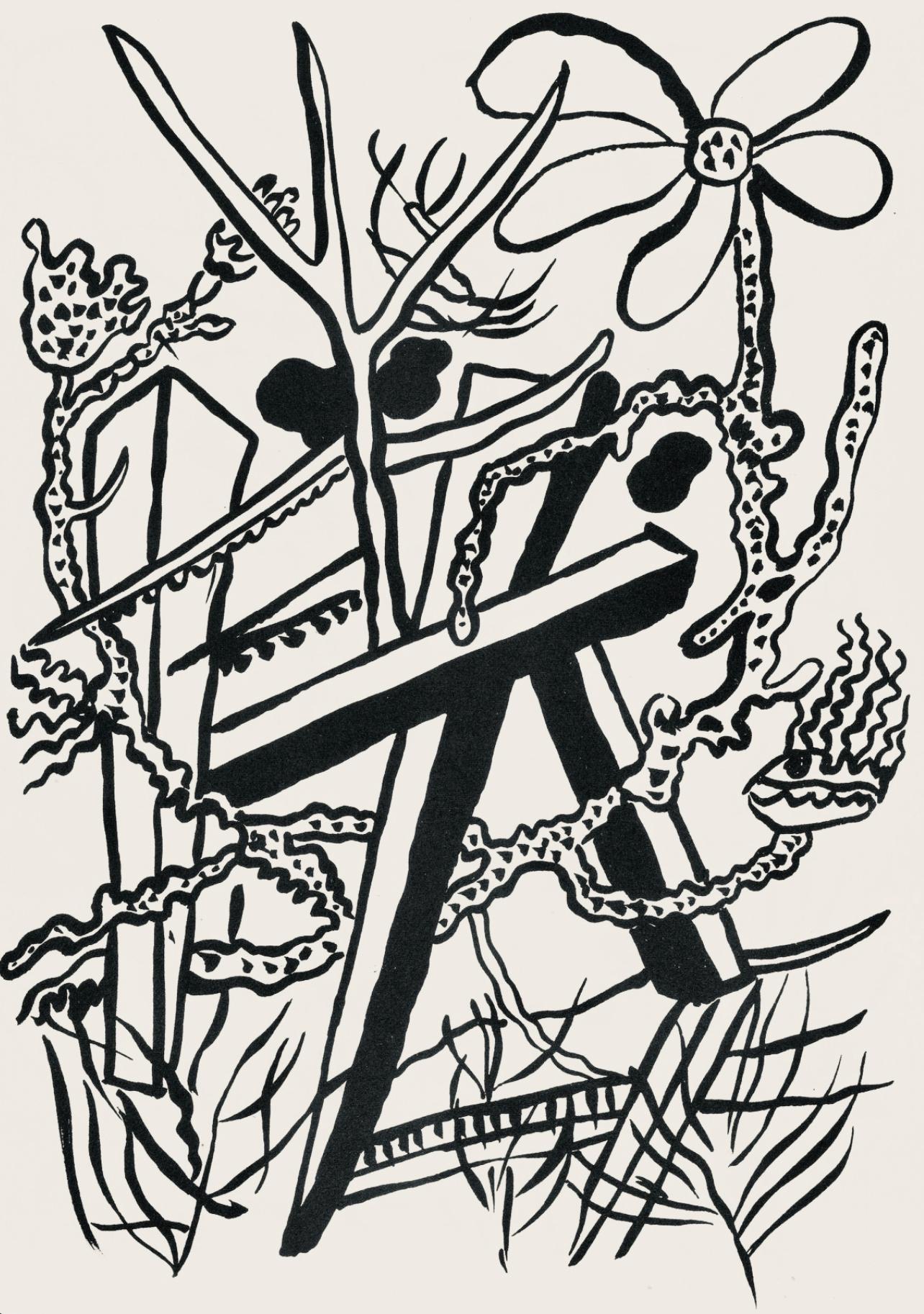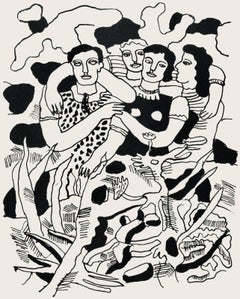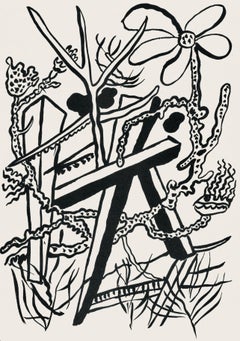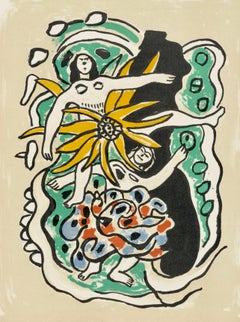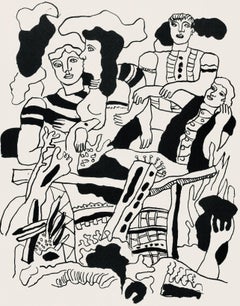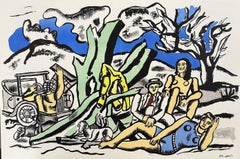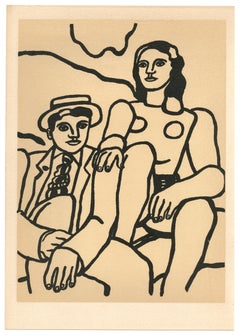Lithographie auf Vélin des Papeteries du Marais Papier. Papierformat: 14 x 20,50 Zoll, mit Mittelfalte, wie ausgegeben. Beschriftung: In der Platte signiert und nicht nummeriert, wie ausgegeben. Referenz des Werkverzeichnisses: Léger, Fernand, und Lawrence Saphire. Fernand LéGer : Das gesamte grafische Werk. Blue Moon Press, 1978, Abbildung E14. Anmerkungen: Aus dem Album, Verve: Revue Artistique et Littéraire, Vol. VII, N° 27-28, 1953. Herausgegeben von Éditions de la revue Verve, Paris, unter der Leitung von Tériade, éditeur, Paris; gedruckt von Mourlot Frères, Paris, 15. Januar 1953, in einer Auflage von MM. Auszug aus dem Album (übersetzt aus dem Französischen): Diese Doppelausgabe von Verve wurde am 15. Januar 1953 von Draeger für die Typografie und den Tiefdruck und von Mourlot für die Lithografie zum Druck gebracht. Zusätzliche Anmerkungen: Auszug aus Poppy Sfakianaki, "La revue Verve (1937-60): Un tremplin pour la carrière de Tériade dans les éditions d'art", Journal of European Periodical Studies, 4.2 (Winter 2019), 70-89, 1937 lernte Tériade (1897-1983) David Smart (1892-1952), den amerikanischen Verleger des Magazins Esquire, kennen, der ihm anbot, an der Gründung der "schönsten Zeitschrift der Welt" mitzuarbeiten. Smart erkannte in Tériade nicht nur seine Fähigkeiten als Verleger und seine Kenntnisse der Kunstgeschichte, sondern auch sein berufliches Netzwerk und den Namen, den er sich in der Pariser Kunstwelt gemacht hatte - alles entscheidende Vorteile für ein Verlagshaus. Mit der kommerziellen Überzeugung, dass sich Schönheit "verkauft", wollte Smart das amerikanische Publikum ansprechen, das sich von der französischen Kunst, einschließlich der modernen Kunst, und dem Mythos des künstlerischen Lebens in Paris angezogen fühlte. Tériade seinerseits sah in der vorgeschlagenen Collaboration die Möglichkeit, sich auf dem amerikanischen Markt zu etablieren - einem starken Verbündeten der modernen Kunst in Frankreich. Éditions de la Revue Verve wurde im November 1937 gegründet, hauptsächlich von Smart finanziert und von Tériade geleitet. Verve: Revue Artistique et Littéraire war eine luxuriöse und ehrgeizige Kunstzeitschrift, die nicht nur auf Französisch, sondern in den ersten Jahren auch auf Englisch erschien und in Europa und den Vereinigten Staaten vertrieben wurde. Der Aufbau der Zeitschrift erinnerte an die französischen Kunstzeitschriften Cahiers d'art, Minotaure und Arts et métiers graphiques sowie an die amerikanische Kunstzeitschrift Coronet. Verve war der Konkurrenz jedoch aufgrund seiner reichhaltigen Ikonographie und der hohen Druckqualität überlegen. Ihr Preis schwankte vor dem Krieg zwischen 60 und 150 Franken (für Doppelnummern) und während des Krieges zwischen 120 und 350 Franken. Aufgrund ihres hohen Preises richtete sich die Zeitschrift vor allem an Kunsthändler, Sammler, Bibliophile und wohlhabende Kunstliebhaber. Die exquisite Ästhetik der Zeitschrift verdankt sich ihrem Chefredakteur Tériade, der eine Plattform für den Dialog zwischen Bild und Text, bildender Kunst und Literatur schaffen wollte. Der dominierende Faktor jeder Ausgabe bleibt die Ikonographie, die sich aus Reproduktionen von Werken moderner Künstler, die Tériade bewunderte, und "Meistern", hauptsächlich der französischen Tradition, zusammensetzt, neben Fotos und Miniaturen mittelalterlicher Handschriften. Tériade verwirklichte mit seiner Zeitschrift zweifellos eine 1934 geäußerte IDEA, wonach Bücher als "ideales Museum" oder als Ausstellung dienen, in der alle künstlerischen Meisterwerke versammelt sind, die Malraux später in Le Musée imaginaire (Genf: Skira, 1947) weiterentwickelte, von dem Teile in Verve erscheinen werden. Während des Zweiten Weltkriegs änderte sich die Periodizität der Zeitschrift, die nun unregelmäßig erscheint, und die behandelten Themen wurden weniger vielfältig. So waren die während des Krieges (sowie 1945 und 1946) erschienenen Ausgaben ausschließlich der Reproduktion mittelalterlicher Buchmalerei gewidmet. Die Sonderhefte der Nachkriegszeit schließlich stellen jeweils die jüngste Produktion eines modernen Malers vor. Nur die Nummern 8 (1940) und 27-28 (1952) bildeten eine Ausnahme mit einer abwechslungsreicheren Zusammenfassung. Die Aufnahme von Verve war positiv, wie mehrere lobende Presseartikel während der gesamten Laufzeit belegen. Der Erfolg der Zeitschrift, Tériades Leidenschaft für moderne Kunst und mittelalterliche Handschriften, seine Bewunderung für die Publikationen von Ambroise Vollard und Albert Skira sowie seine Kenntnis der bibliophilen Welt veranlassten ihn bald, seine redaktionelle Tätigkeit auszuweiten. Trotz der praktischen Schwierigkeiten, die der Krieg mit sich brachte, wurde 1943 sein erstes Künstlerbuch veröffentlicht, das von Georges Rouault geschrieben und illustriert wurde. Bis 1975 veröffentlichte Tériade Éditions de la Revue Verve neun Bücher von modernen Künstlern wie Henri Matisse, Pablo Picasso, Marc Chagall, Joan Miró, die vollständig von den Künstlern verfasst wurden (Text und Bilder); siebzehn von anerkannten modernen Künstlern illustrierte Bücher; ein Album mit Lithografien von Fernand Léger über Paris, zwei Fotoalben von Henri Cartier-Bresson, zwei Monografien über die Künstler André Beaudin und Francisco Borès, eine luxuriöse Serie von Reproduktionen mittelalterlicher Buchmalereien und eine Reihe von Mappen über die große französische Architektur. Letztlich zeigt die vergleichende Studie der Zeitschrift und der Ausgaben von Verve: Revue Artistique et Littéraire die Bedeutung der stillschweigenden Beziehungsdynamik, die sich aus den Beziehungen der Collaboration und des Austauschs von symbolischem Kapital ergibt, das auf gemeinsamen Wahrnehmungen und Interessen sowie auf Gefühlen der gegenseitigen Freundschaft und Wertschätzung von Akteuren in der Kunstwelt beruht, die eine visuelle und bibliophile Kultur teilen und so zum Erfolg der Zeitschrift und des Verlags beitragen.
FERNAND LEGER (1881-1955) war ein französischer Maler, Bildhauer und Filmemacher. In seinen frühen Werken schuf er eine persönliche Form des Kubismus (bekannt als "Tubismus"), die er allmählich zu einem eher figurativen, populistischen Stil modifizierte. Seine kühn vereinfachte Behandlung moderner Themen hat dazu geführt, dass er als ein Vorläufer der Pop Art gilt. Léger wurde in Argentan an der Orne in der Basse-Normandie geboren, wo sein Vater Viehzucht betrieb. Fernand Léger absolvierte von 1897 bis 1899 zunächst eine Ausbildung zum Architekten, bevor er im Jahr 1900 nach Paris zog, wo er sich als Architekturzeichner durchschlug. Nach dem Militärdienst in Versailles (Yvelines) in den Jahren 1902-1903 schrieb er sich an der Schule für dekorative Künste ein, nachdem seine Bewerbung an der École des Beaux-Arts abgelehnt worden war. Dennoch besuchte er die Beaux-Arts als nicht eingeschriebener Student und verbrachte, wie er es nannte, "drei leere und nutzlose Jahre" bei Gérôme und anderen, während er gleichzeitig an der Académie Julian studierte. Erst im Alter von 25 Jahren begann er, ernsthaft als Maler zu arbeiten. Zu diesem Zeitpunkt zeigt sein Werk den Einfluss des Impressionismus, wie in Le Jardin de ma mère (Der Garten meiner Mutter) von 1905, einem der wenigen Gemälde aus dieser Zeit, das er später nicht zerstört hat. Nachdem Léger die Cézanne-Retrospektive auf dem Salon d'Automne 1907 gesehen hatte, wurde die Zeichnung und die Geometrie in seinem Werk neu betont. Im Jahr 1909 zieht er nach Montparnasse und lernt Alexander Archipenko, Jacques Lipchitz, Marc Chagall, Joseph Csaky und Robert Delaunay kennen. Im Jahr 1910 stellt er auf dem Salon d'Automne im selben Saal (salle VIII) wie Jean Metzinger und Henri Le Fauconnier aus. In seinem wichtigsten Gemälde aus dieser Zeit, Akt im Wald, zeigt Léger eine persönliche Form des Kubismus, die seine Kritiker wegen der Betonung zylindrischer Formen als "Tubismus" bezeichneten. 1911 versammelte das Komitee des Salon des Indépendants die als "Kubisten" bezeichneten Maler. Metzinger, Albert Gleizes, Le Fauconnier, Delaunay und Léger waren dafür verantwortlich, dass der Kubismus zum ersten Mal als organisierte Gruppe einem breiten Publikum vorgestellt wurde. Im darauffolgenden Jahr stellte er erneut auf dem Salon d'Automne und Indépendants mit den Kubisten aus und schloss sich mit mehreren Künstlern wie Le Fauconnier, Metzinger, Gleizes, Francis Picabia und den Brüdern Duchamp, Jacques Villon, Raymond Duchamp-Villon und Marcel Duchamp zur Gruppe Puteaux zusammen - auch Section d'Or (Goldene Sektion) genannt -, deren Gemälde von da an bis 1914 immer abstrakter wurden. Ihre röhrenförmigen, kegelförmigen und würfelförmigen Formen werden lakonisch in groben Flecken aus Primärfarben sowie Grün, Schwarz und Weiß wiedergegeben, wie in der Gemäldeserie mit dem Titel Contrasting Forms zu sehen ist. Die von Braque und Picasso eingeführte Technik der Collage wird von Léger nicht verwendet.

